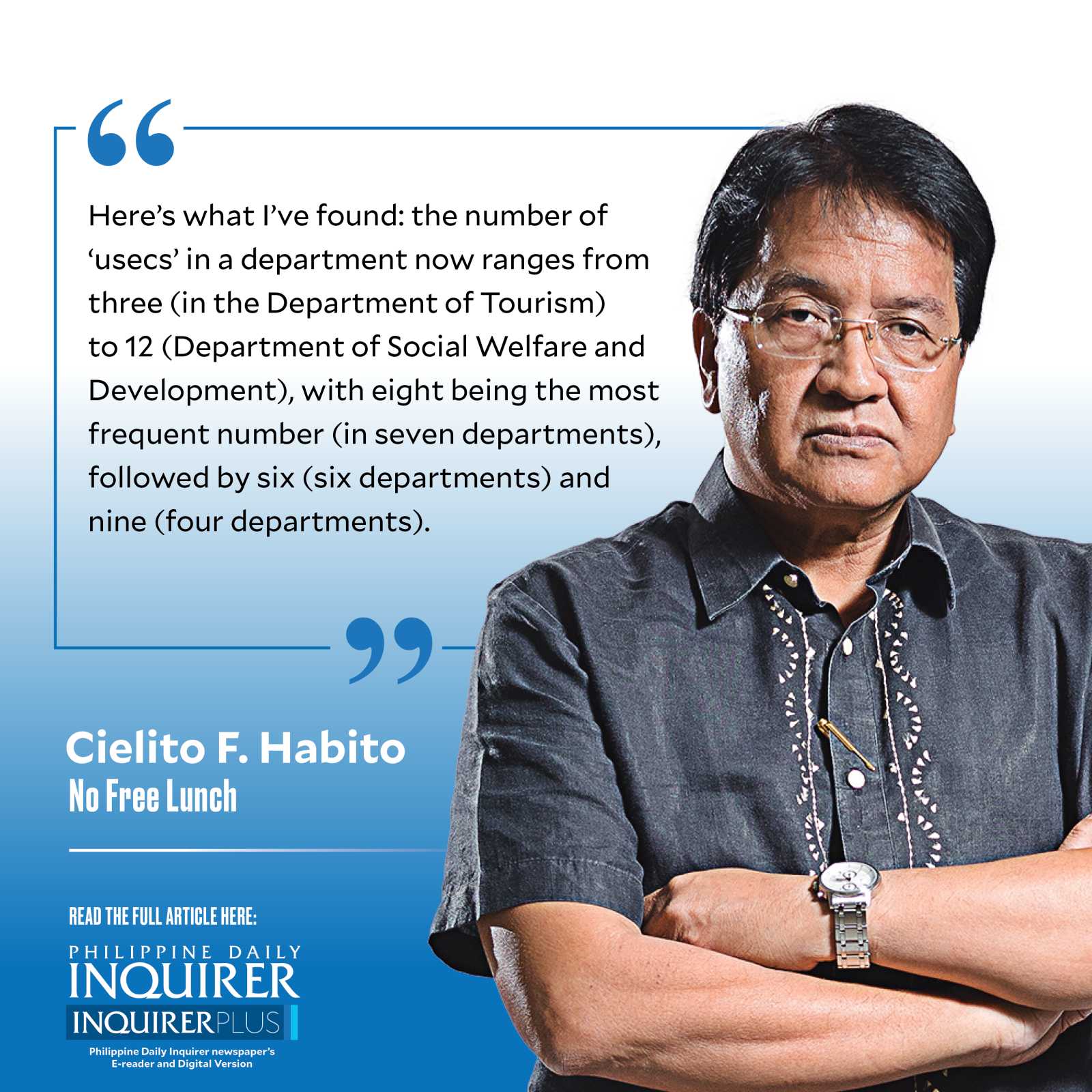Top-heavy bureaucracies

Back around 1990, the late radio commentator Louie Beltran (bless his soul) joked that if you figure in a car collision in the city, chances are that the other car would be carrying an undersecretary—in a dig at how there were so many of them in government. Not long after that, President Cory Aquino ordered all government departments to have no more than three undersecretaries (“usecs”) and three assistant secretaries (“asecs”) each. I recall both the joke and the presidential order quite well because they came soon after she appointed me to be one of five assistant secretaries (aka assistant directors general or ADGs) at the National Economic and Development Authority (Neda) then. My boss, the late Secretary Dondon Paderanga (bless his soul too), had to let go of two of Neda’s asecs; he already had the maximum three usecs then. Other departments made similar adjustments to adhere to the Palace’s 3-3 rule, and the streamlined top leadership structure got carried on to the Fidel V. Ramos presidency.
Now, over three decades later, Beltran’s son Cito, who took after his father’s journalistic career, could well crack his dad’s joke all over again. In a press release last week, the Department of Agriculture (DA) announced its new lineup of eight undersecretaries and nine assistant secretaries, along with dozens of directors heading various bureaus, attached agencies, and offices under it. When someone posted the news in a chat group, I couldn’t resist chiming in: “In a supposedly devolved agriculture and fisheries system, you don’t need such a top-heavy bureaucracy. No wonder too little money goes to actually helping our farmers raise their productivity. We’re simply paying too many bureaucrats!”—and I mentioned the 3-3 rule that prevailed in the 1990s.
This led me to scan different departments’ websites to see their organizational and leadership structures, and here’s what I’ve found: the number of usecs in a department now ranges from three (in the Department of Tourism) to 12 (Department of Social Welfare and Development), with eight being the most frequent number (in seven departments), followed by six (six departments) and nine (four departments). Meanwhile, the number of asecs ranges from one (DOT again) to 17 (DSWD again), with seven being the most frequently occurring number. The majority of departments have seven asecs or more. The Department of Foreign Affairs, with 14 asecs, even has additional positions called “deputy assistant secretaries.” Compared to line-ups under the Duterte administration, 10 departments actually increased the number of their top officials, led by DSWD, which increased usecs from seven to 12, and asecs from eight to 17. (And we still haven’t counted the many usecs and asecs in the Office of the President itself, plus heads of various agencies with the rank of undersecretary—who invariably prefer to use and be addressed by that title over their actual designations as agency heads.)
Article continues after this advertisementI find it particularly remarkable that those departments with functions that had been devolved by law to local governments for over three decades now (i.e., since the Local Government Code of 1991) are among the most top-heavy bureaucracies in the Philippine government. These are DSWD, with a glaringly top-heavy structure that has 12 usecs and 17 asecs; Department of Health (DOH), with nine usecs and seven asecs; and DA, with eight and nine usecs and asecs, respectively. DA actually had even more usecs (11) under the previous administration. It seems a contradiction that there are so many top-level officials in government departments whose roles have long been reduced to “steering” while local government units (LGUs) have been tasked with their devolved “rowing” functions. In fact, the good governance principle of subsidiarity—deciding and acting at the level of governance closest to the problems being addressed—must be upheld well beyond DSWD, DOH, and DA to all national government agencies (NGAs).
It’s in this light that I see the President’s recent order for NGAs to define and determine their priority core functions and services that should be further devolved to the LGUs as a move in the right direction and a welcome reform initiative. For one thing, the pathetic state of Philippine agriculture largely traces to the DA’s long-standing propensity for top-down governance of the sector with “one-size-fits-all” (and often corruption-tainted) fixes, despite widely diverse local conditions. The DA, DOH, DSWD, and all other agencies with devolvable functions should have long given attention and budgets to capacitating, empowering, and funding LGUs to do their work for them, hence work through better-equipped LGUs, not on top of them.
That way, budgets now spent to support salaries and offices of all those excess usecs and asecs could likely achieve a much greater good for a far greater number.
Article continues after this advertisement—————-
cielito.habito@gmail.com
















